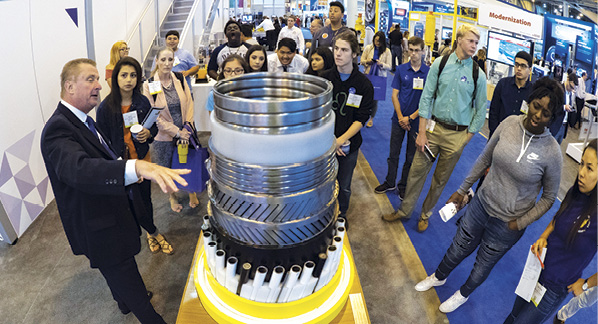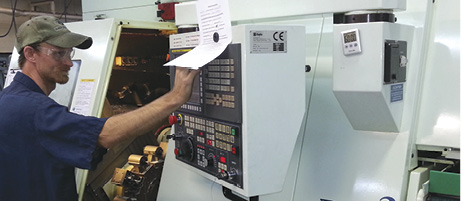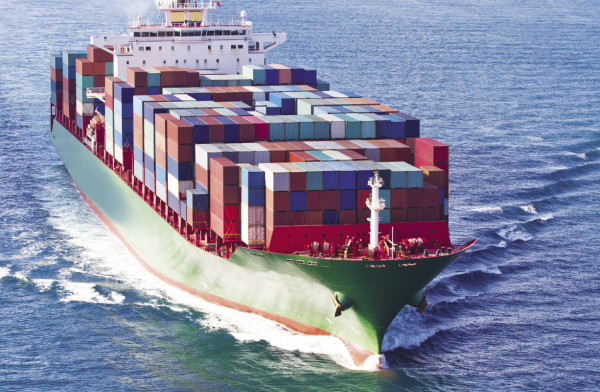ROVs: The Workhorse of Subsea Hydraulic Systems
By Steve Barrow, Regional Sales Manager, Wandfluh of America
Offshore and subsea equipment faces challenges unparalleled in other industries. Difficulties can include crushing ambient pressures, corrosive environments, and remote locations.
Why would anyone choose to work in such difficult and harsh conditions? Since 71% of the earth is covered in water, humans have learned to work in and around it. The market for subsea equipment is large and includes alternative energy, oil and gas, military, fishing, and scientific.
Valves are critical to the operation of subsea hydraulic equipment. Valves used offshore and subsea must have exceptional reliability, operate precisely and responsively, be compatible with a wide range of fluids, include corrosion protection, and be compatible with electronic control systems.
Hydraulic systems on ROVs
Though many types of subsea equipment use hydraulic power, remotely operated vehicles (ROVs) offer an excellent example of complex mobile electrohydraulic subsea systems. These robotic systems work in depths unsafe for human divers or in hazardous polluted environments such as those created by maritime disasters. ROV equipment can operate at depths greater than 13,000 feet (4,000 meters). ROV hydraulic components require special modifications to withstand the rapid pressure change from sea level to the abyss, where the ambient pressure exceeds 6,000 psi (414 bar).
Most work-class ROVs use hydraulic power for primary operational equipment, including thrusters, manipulators (robotic arms), and auxiliary tooling. An onboard hydraulic power unit (HPU) typically provides hydraulic power in the range of 150 to 250 horsepower. The HPU runs on electricity transmitted from a surface vessel to the ROV through an electrical “umbilical” cable. A proportional pressure-relief cartridge controls the output pressure of the variable displacement pump providing hydraulic power throughout the system.
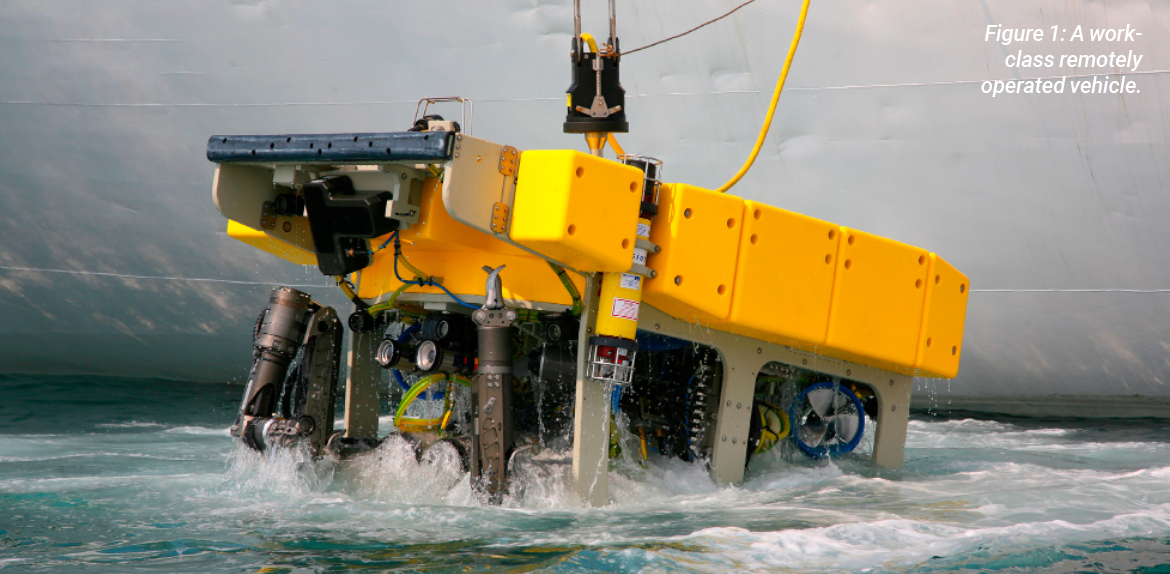
As is true for most offshore equipment, minimizing the size and weight of ROV equipment is critical to its successful function. Hydraulic systems offer an excellent power-to-weight ratio (power density) in the smallest possible mechanical envelope. Higher pressures allow the use of smaller hydraulic actuators and components, which in turn limits the total volume of hydraulic fluid required for the system. Both factors reduce system weight. For safety, longevity, and reliability on these high-cost vehicles, the hydraulic valves must be fully compatible with the subsea operating environment. Special features such as pressure compensation ensure proper operation at extreme depths. Hydraulic fluids must tolerate water ingression – an accepted inevitability for subsea operations – and support long-term environmental friendliness (figure 1).
Critical hydraulic equipment is not limited to the subsea vehicle. The host vessel has a launch-and-recovery system that includes a high-tension winch. Because the ROV’s water-cooled electric motor would overheat very quickly in air, a deck HPU tests on-deck vehicle function and flushes the system of water after a dive. A crane lowers subsea hardware or tooling to the ROV. All this equipment must be robust, reliable, and able to function in corrosive and sometimes explosive environments.
Reliability
Equipment reliability is critical to the cost-effective operation of subsea hydraulic equipment. For example, to accomplish their tasks, ROVs frequently remain submerged for weeks without maintenance. If a system failure occurs and an ROV must be recovered for repair, it takes about eight hours to raise the ROV to the surface vessel and return it to a depth of 13,000 feet (4,000 meters). Repairing the failed components takes additional time, and the limited availability of spare parts in the middle of the ocean can make repairs difficult or even impossible. If the ROV’s task is critical to the vessel’s mission, the down ROV can bring the vessel and crew to a standstill.
Because reliability of hydraulic components is critical to operations in subsea systems, Wandfluh tests valve products to ten million cycles of service life. Wandfluh designs and manufactures solenoids in house to ensure quality and conformity to subsea specifications and standards. The solenoid tube assembly, critical for smooth valve operation, is constructed of the highest quality materials. It is also designed to ensure the strongest magnetic field at the lowest power levels, resulting in reduced hysteresis.
Pressure compensation
Although oil is generally considered incompressible, oil and the gas molecules entrained within the oil do compress slightly under high pressure. Compressibility varies by fluid type and other factors, but a common rule of thumb is that oil compresses 0.5% per 1,000 psi (69 bar). This compression, at an ambient pressure of 6,000 psi (414 bar), produces a volumetric change of 3%. Temperature difference between the deck of the surface vessel and the ocean depths exacerbates this volume change. Without compensating for the volumetric change inside an enclosure, stresses build that could cause the equipment to deform or implode. To allow for volume changes, Wandfluh modifies the solenoid housing and coil in its valves to allow small amounts of oil to pass freely, preventing differential pressures. Electronics testing ensures that they can withstand cycling of ambient temperature and pressure as the hydraulic equipment repeatedly descends and returns to the surface.
Efficiency and responsiveness
The inherent design of a spool valve allows controlled leakage around the spool to reduce friction and improve response time and performance. However, this leakage can reduce the valve’s efficiency and reduce the amount of fluid available for system functions. Wandfluh designs spool valves with tight tolerances and precision finishing processes that reduce leakage rates, resulting in greater efficiency and greater fluid availability. The increased efficiency allows a smaller pump to provide weight reduction and additional cost savings.
Proportional spool valves commonly control the precision motion of an ROV’s manipulators. The manipulators can be powerful, capable of lifting more than 500 pounds (225 kg) in air, but they must also be responsive, with smooth, refined control that allows the ROV to adjust sensitive components on subsea equipment. Wandfluh’s compact NG3 Mini WDPFA03 or the larger flow NG6/CETOP3 WDPFA06 proportional directional control valves are commonly used for manipulator control and auxiliary tooling functions.
ROVs are propelled through water by a set of seven or eight powerful thrusters mounted on the ROV frame, with each thruster driven by a hydraulic motor. Some ROV manufacturers use Wandfluh’s proportional D05 directional valves to control the speed and direction of flow for each thruster. Other manufacturers control the torque at each thruster using a pair of MVPPM33 proportional pressure-reducing and pressure-relieving valves. Both methods enable moving the ROV through the water with precise vertical and horizontal positioning.
Hydraulic fluid compatibility
Hydraulic fluid for subsea equipment needs to meet standard terrestrial requirements such as wear reduction, lubricity, viscosity range, and environmental friendliness, but it must also allow some tolerance to water ingression.
In recent years, industries have increasingly turned to more environmentally friendly and fire-resistant hydraulic fluids, but these fluids pose significant challenges due to their lower lubricity, reduced corrosion inhibitors, and lower viscosity. Some of these fluids have high water content, making standard valves unsuitable in terms of useful lifetime, safety, reliability, and cost effectiveness.
To meet the demands of subsea hydraulic systems that use environmental fluids, Wandfluh developed the Z595 valve, a special design with new materials and construction techniques. The internal components of these valves use various grades and hardness of stainless steel to prevent galling. They are compatible with fire-resistant HFC and HFA fluids as well as water-glycol-based fluids with water content as high as 95%. Optimized spool design, offering higher resistance to internal cavitation caused by the lower-viscosity fluids at high pressure, extends the valve’s life.
Valve packs
Subsea valve packs commonly consist of valves installed into a manifold. Solenoid valves and an electronic communication and control card are enclosed in an oil-filled housing to prevent water from directly contacting the valves and coils. CETOP and sandwich valves allow each stack to be customized with valves of differing sizes and functions, as shown in the photograph below. Proportional control of flow rate/direction and pressure is available. Pilot-operated and cross-pilot control valves can also be installed.
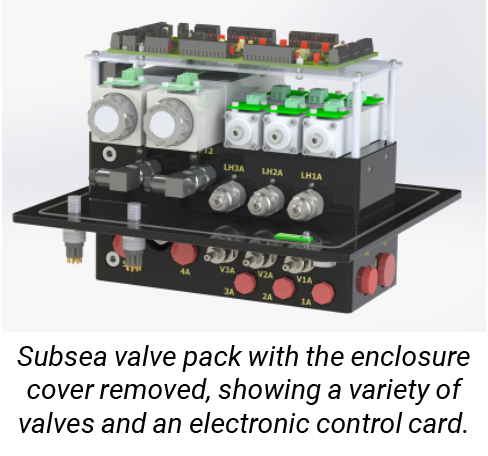
Cartridge valves installed on the lower faces of the manifold, outside the oil-filled protective enclosure, allow easy access for manual adjustments. The external faces of these valves are directly exposed to seawater.
Support equipment on the deck of a vessel is continuously exposed to the harsh marine environment. Valves on this equipment require materials and coatings specially designed for these conditions.
Corrosion protection
Wandfluh’s protection options safeguard valves against corrosion. Standard K8 protection on valves uses a zinc-nickel coating on the valve body and solenoid housing exterior, with zinc-coated fasteners. K8 valves rate highly, with n>500 hours of rust protection in the globally accepted ISO 9227 standards for red-rust, salt-spray tests. The K9 valves use high-grade AISI 316L acid-resistant stainless steel for the external valve components and zinc-nickel coating for the solenoid housing. K9 valves have a rust protection rating of n>1,000 hours in testing. K10 valves offer the highest level of corrosion protection. All external elements of K10 valves, including the solenoid housing, are made of high-grade stainless steels. K10 valves also have the superior rating of n>1,000 hours of rust protection (figure 2).
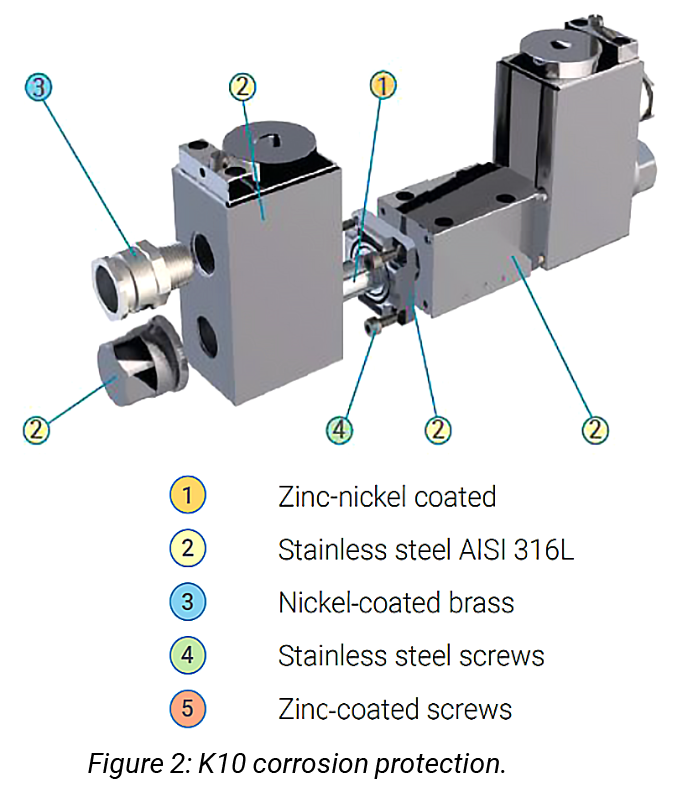
Electronic control
Precision electronic control systems achieve wide versatility and optimal control of hydraulic systems. Amplifier or controller electronics mounted directly onboard the solenoids control the solenoid valves. They can also be wired to pressure-tolerant, smart-valve pack control cards, controlled through serial (RS-232/485), ethernet, or CAN bus communications.
Multiple electrical connection styles on the solenoid include the popular DIN 43650-A/ISO 4400, Deutsch, AMP Junior Timer, and Phoenix connectors, as well as flying leads. Because of their low profiles, flying leads save space. But if the leads are damaged close to the solenoid, repair may not be possible. The small Phoenix connectors provide a good compromise between space savings and component protection.
Valves are critical to operating hydraulic subsea equipment. Many field-proven standard options become building blocks that create the exact solution for a challenging application.


